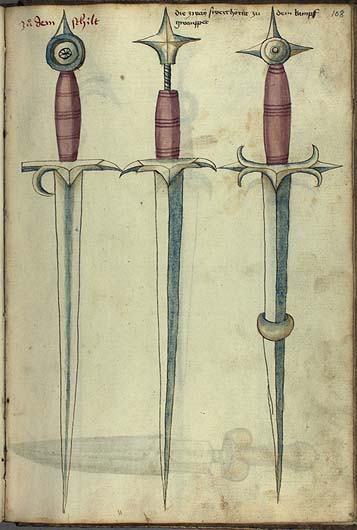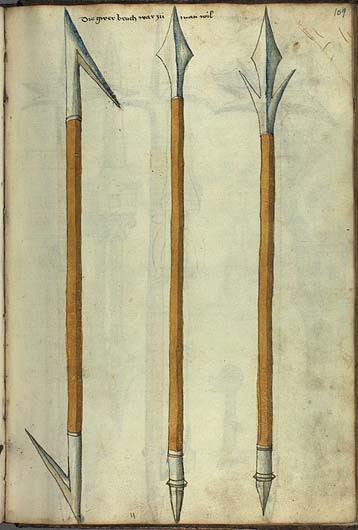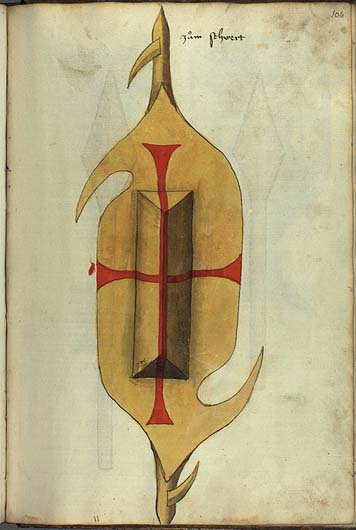I started collecting last year with the Albion 1st Generation Crecey Grete. I posted about wanting a longer grip length on several occasions and had various responses about the style of sword that I wanted (and believed depicted in fechtbooks) as being more likely a specialized dueling sword.
Recent forum posts have illustrated that there were weapons specialized just for dueling;
http://www.myArmoury.com/talk/viewtopic.php?t=6251
I have on several occasions searched for information specifically about types of weapons used in judicial combat (1000 A.D. to 1400 A.D.), but generally did not discover anything. I would appreciate it if anyone who has expertise in the area would comment or reference texts with significant comment on the weapons used in duels.
I suspect that many may have participated in judicial combat, and possibly several times during their life. Recent books I have read with accounts of Bertrand Du Guesclin and William Marshall’s feats included accounts of several “judicial duels” and very lethal passage de arms contests each. This surprised me.
As a byproduct of my searching, I found some accounts of judicial duels and lethal combat for sport. I hope others may enjoy browsing some of these.
One of the earliest accounts I came across..
http://www.fordham.edu/Halsall/source/12Cduels.html
An account of a duel in 1127 AD, may appeal to sopranos…
http://facstaff.uww.edu/jaffej/great_trials/combat.pdf
An Account of the Duel between Jean de Carrouges and Jacques le Gris in the Chronicle of the Monk of St. Denis, 1389
http://www.nipissingu.ca/department/history/M...ELIG3E.HTM
Method of a 14th century duel between John Astley, Squire, to Philip Boyle, Knight of Aragon On the occasion of his knighting, 1442
http://www.chronique.com/Library/Tourneys/Phi...llenge.htm
ARMA article on a famous 15th century duel between Jarnac and Châtaigneraye - France, 1547 (one of the latest I found using medieval type weapons in sword combat)
http://www.thearma.org/essays/DOTC.htm
ARMA article on the deeds of 15th century knight Jacques de Lalaing (lethal contests)
http://www.thearma.org/essays/Lalaing.htm
Tragic tale of a rather late medieval period duel that is the subject of a recent book “The Last Duel” http://www.nipissingu.ca/department/history/M...ELIG3E.HTM
A topic that seems to come up occasionally is the wisdom of attacking an opponents legs and how inconsistent this is with traditional fechtbook interpretations. As a matter of historical record, it seems accomplished combatants did it fairly often with success.
http://www.thearma.org/essays/LegWounds.htm
Hi Jared.......This topic fascinates me as well. I wish I has money to buy the books on such things ( I assume there are some ) but I must concentrate on other medieval topics at the moment. I came across this article today at AEMMA .......
http://www.aemma.org/onlineResources/extras/hergsell1443/main.htm .....
Talhoffers Fechtbuch (Gothaer Codex)
aus dem Jahre 1443"
Section 3: Hewing Shields et al..
" An unusal presentation that begins with an illustration of a bizarre hewing shield however, the actual hewing shield techniques comprise only 10 plates of the 26 plates in this section. Interspersed with the plates illustrating hewing shields techniques are images that reflect Hergsell's interpretation and presentation of medieval life. Numerous illustrations with strong religious overtones, one illustration that appears to depict a fox hunt and another depicting individuals in what appears to be an encampment with 2 individuals sitting at a table whereby one is playing a stringed instrument, the second appears to be holding/examining a sword, and the third individual sitting in a tub filled with water and a tray affixed across it with drinks and food layed out on it. "
Then there's the Judicial combat where the the men are (apparently, I'm told) stitched into leather "wetsuits" and covered with grease. Then they have swords, clubs and "Hewing shields" or just the shields themselves which, as the illustration shows, can do quite enough damage alone......
 Attachment: 87.51 KB
Attachment: 87.51 KB
[ Download ]
http://www.aemma.org/onlineResources/extras/hergsell1443/main.htm .....
Talhoffers Fechtbuch (Gothaer Codex)
aus dem Jahre 1443"
Section 3: Hewing Shields et al..
" An unusal presentation that begins with an illustration of a bizarre hewing shield however, the actual hewing shield techniques comprise only 10 plates of the 26 plates in this section. Interspersed with the plates illustrating hewing shields techniques are images that reflect Hergsell's interpretation and presentation of medieval life. Numerous illustrations with strong religious overtones, one illustration that appears to depict a fox hunt and another depicting individuals in what appears to be an encampment with 2 individuals sitting at a table whereby one is playing a stringed instrument, the second appears to be holding/examining a sword, and the third individual sitting in a tub filled with water and a tray affixed across it with drinks and food layed out on it. "
Then there's the Judicial combat where the the men are (apparently, I'm told) stitched into leather "wetsuits" and covered with grease. Then they have swords, clubs and "Hewing shields" or just the shields themselves which, as the illustration shows, can do quite enough damage alone......
[ Download ]
Awesome stuff. Just awesome. No battles like the present...
These are from our good friend....Talhoffer.........
 Attachment: 37.1 KB
Attachment: 37.1 KB

 Attachment: 33.69 KB
Attachment: 33.69 KB

 Attachment: 31.01 KB
Attachment: 31.01 KB




Hi all ^^ :)
How did Jean de Carrouges kill Jacques le Gris?
Mr. Jared Smith wrote:
excerpted:
And when the marshal gave the signal for the attack, they drove their horses forward, let their lances of war drop, and proceeding at a gentle pace, they dashed against each other courageously and with spirit. In this first rush the other man pierced Lord Jean’s thigh with his lance; and this blow would have done him much good if he had held the lance in that wound. But when he immediately drew it out, it was covered in blood, and the sight, rather than stunning the wounded man, made him bolder. Meanwhile, great horror paralyzed the spectators for a long time, and no one spoke or breathed, held as they were between hope and fear, until Jean gathered his strength, and advancing, shouted “This day will decide our quarrel.” With his left hand he seized the top of his opponent’s helmet, and drew Jacques toward him and then pulling back a little, threw Jacques to the ground where he lay weighed down by his armor. Jean then drew his sword and killed his enemy, though with great difficulty, because he was fully armored.
Where of the body of Gris did Carrouges attack with a sword? :?:
http://www.nipissingu.ca/department/history/m.../trial.htm
excerpted:
The two champions were then advanced, and placed opposite to each other; when they mounted their horses, and made a handsome appearance, for they were both expert men at arms. They ran their first course without hurt to either. After the tilting, they dismounted, and made ready to continue the fight. They behaved with courage; but sir John de Carogne was, at the first onset, wounded in the thigh, which alarmed all his friends: notwithstanding this, he fought so desperately that he struck down his adversary, and, thrusting his sword through the body, caused instant death; when he demanded of the spectators if he had done his duty: they replied that he had.
Where of the body of Gris did Carrouges thrust with a sword? :?:
I read "The Last Duel(Japanese edition)" by Eric Jager. (now I'm reading English edition. The same things are written in English/Japanese edition.)
I think that most of the scene of the duel were written by the imagination of the author. :(
The scene of the duel has a strange description so that Hugh Knight has already pointed it out...
http://www.myArmoury.com/talk/viewtopic.php?p...ris#110591
excerpted from "The Last Duel(English edition)" by Eric Jager
Was the scene of these fights written by the imagination of the author? :?:
Are there chronicles which these descriptions appear in? :?:
I have another questions... :?:
* Are there the illust of this duel? :?:
* What kind of armour did they wear? :?:
* What kind of sword/dagger/axe did they use/equipe? :?:
Thanks ^^
p.s.
http://www.themovieinsider.com/m3863/the-last-duel/ :eek:
http://www.imdb.com/title/tt0913961/
http://www.bbc.co.uk/programmes/b0074sh3 (I'am interested...)
How did Jean de Carrouges kill Jacques le Gris?
Mr. Jared Smith wrote:
| Quote: |
| An Account of the Duel between Jean de Carrouges and Jacques le Gris in the Chronicle of the Monk of St. Denis, 1389
http://www.nipissingu.ca/department/history/M...ELIG3E.HTM |
excerpted:
And when the marshal gave the signal for the attack, they drove their horses forward, let their lances of war drop, and proceeding at a gentle pace, they dashed against each other courageously and with spirit. In this first rush the other man pierced Lord Jean’s thigh with his lance; and this blow would have done him much good if he had held the lance in that wound. But when he immediately drew it out, it was covered in blood, and the sight, rather than stunning the wounded man, made him bolder. Meanwhile, great horror paralyzed the spectators for a long time, and no one spoke or breathed, held as they were between hope and fear, until Jean gathered his strength, and advancing, shouted “This day will decide our quarrel.” With his left hand he seized the top of his opponent’s helmet, and drew Jacques toward him and then pulling back a little, threw Jacques to the ground where he lay weighed down by his armor. Jean then drew his sword and killed his enemy, though with great difficulty, because he was fully armored.
Where of the body of Gris did Carrouges attack with a sword? :?:
http://www.nipissingu.ca/department/history/m.../trial.htm
excerpted:
The two champions were then advanced, and placed opposite to each other; when they mounted their horses, and made a handsome appearance, for they were both expert men at arms. They ran their first course without hurt to either. After the tilting, they dismounted, and made ready to continue the fight. They behaved with courage; but sir John de Carogne was, at the first onset, wounded in the thigh, which alarmed all his friends: notwithstanding this, he fought so desperately that he struck down his adversary, and, thrusting his sword through the body, caused instant death; when he demanded of the spectators if he had done his duty: they replied that he had.
Where of the body of Gris did Carrouges thrust with a sword? :?:
I read "The Last Duel(Japanese edition)" by Eric Jager. (now I'm reading English edition. The same things are written in English/Japanese edition.)
I think that most of the scene of the duel were written by the imagination of the author. :(
The scene of the duel has a strange description so that Hugh Knight has already pointed it out...
http://www.myArmoury.com/talk/viewtopic.php?p...ris#110591
| Quote: |
| Incidentally, while Jager's overall historical facts may be good (although he should be boiled in oil for his lack of references and footnotes), his information about 14th-century armored combat is extremely innacurate, so be wary of anything he says. For example, on p. 174 he says that Carrouges pulled his sword: "This was the shorter, one-handed blade--or estoc--worn on his belt." Now this blade may have been an estoc, but the vast majority of estocs (or tucks) I have seen are two handed. It's far more likely this was simply a typical 14th-century type XV arming sword, and Jager confused it with the tuck because both are kind of pointy. Then on p. 176 he says that Le Gris was unable to rise to his feet because of the weight of his armor; because of his exhaustion, or because of the shock of being knocked down possibly, but because of the weight of his armor? Hollywood nonsense. Then on p. 177 he compounds the error by saying "fallen knights were often butchered like lobsters in their own shells". On p. 178 Jager says that Carrouges fumbled with the lock holding Le Gris' visor shut; nonsense, there's no evidence for any such lock this early. Jager makes a lot of claims about details of this duel (e.g., that Carrouges intended to use the Bec of his axe to strike), but his lack of documentation combined with his obvious lack of understanding of the armor and weapons of the day casts a deep and long shadow of doubt over everything he wrote. |
excerpted from "The Last Duel(English edition)" by Eric Jager
| Quote: |
| But as the panting knight stood over his fallen opponent, his sword at the ready, looking for the kill, this was hardly the end of Jacques Le Gris. ......
"He searched a long time for a crack or crevice in his enemy's armor, but the squire was covered from head to foot in steel." ...... Now began a deadly struggle on the ground, as Carrouges straddied Le Gris, one knee to each side of his chest, and began stabbing at his helmet with the point of his sword. ...... The visor sprang open, exposing Le Gris's face from his forehead down to below his chin. ...... With that, Carrouges put the point of his dagger to the squire's underjaw, while bracing the helmet with his free hand, and with all of his remaining strength drove the sharp thin blade into the exposed white flesh, sinking the weapon into his enemy's throat up to the hilt. ...... |
Was the scene of these fights written by the imagination of the author? :?:
Are there chronicles which these descriptions appear in? :?:
I have another questions... :?:
* Are there the illust of this duel? :?:
* What kind of armour did they wear? :?:
* What kind of sword/dagger/axe did they use/equipe? :?:
Thanks ^^
p.s.
http://www.themovieinsider.com/m3863/the-last-duel/ :eek:
http://www.imdb.com/title/tt0913961/
http://www.bbc.co.uk/programmes/b0074sh3 (I'am interested...)
Fiore and Vadi both have pictures of special duelling swords in their manuals, and Vadi adds a detailed description. Fiore writes that he trained many famous men for formal combat in the barriers.
I don't know of a published edition of Fiore with both pictures and translated text. A translation and facsimile of Vadi was put out by Chivalry Bookshelf (I've linked to it).
I found an account of a judicial duel in 15th century England between two commoners wearing leather and armed with a single club each. I'll see if I can find the reference.
Incidentally, the reason you shouldn't strike to the leg when armed with a single weapon is that its generally easy to defend against (by retreating the threatened leg while counter-cutting) and leaves the attacker open while his sword is low. Having two weapons changes things because you can protect against the counterattack with the second weapon. Of course, its likely that many historical fencers had never learned this.
I don't know of a published edition of Fiore with both pictures and translated text. A translation and facsimile of Vadi was put out by Chivalry Bookshelf (I've linked to it).
I found an account of a judicial duel in 15th century England between two commoners wearing leather and armed with a single club each. I'll see if I can find the reference.
Incidentally, the reason you shouldn't strike to the leg when armed with a single weapon is that its generally easy to defend against (by retreating the threatened leg while counter-cutting) and leaves the attacker open while his sword is low. Having two weapons changes things because you can protect against the counterattack with the second weapon. Of course, its likely that many historical fencers had never learned this.
Page 1 of 1
You cannot post new topics in this forumYou cannot reply to topics in this forum
You cannot edit your posts in this forum
You cannot delete your posts in this forum
You cannot vote in polls in this forum
You cannot attach files in this forum
You can download files in this forum
All contents © Copyright 2003-2006 myArmoury.com — All rights reserved
Discussion forums powered by phpBB © The phpBB Group
Switch to the Full-featured Version of the forum
Discussion forums powered by phpBB © The phpBB Group
Switch to the Full-featured Version of the forum